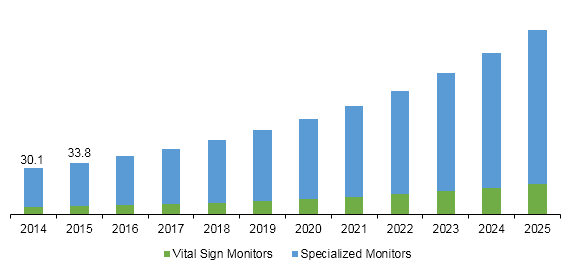
Germany Remote Patient Monitoring Device Market Size and Forecast by Product (Vital Sign Monitors, Specialized Monitors), by Application, by End Use And Trend Analysis, 2014 - 2025
- Published: July, 2018
- Format: Electronic (PDF)
- Number of pages: 100
- Industry: Healthcare
Industry Insights
The Germany remote patient monitoring device market size was valued at USD 42.9 million in 2017 and is projected to expand at a subsequent CAGR over the forecast period. Factors such as increasing geriatric population coupled with rising prevalence of chronic conditions is driving the market. Rising demand for the wireless and portable systems and quality care along with increasing need for cost-effective treatment are other factors promoting the industry development.
Germany remote patient monitoring device market revenue, by product, 2014 - 2025 (USD Million)

Government initiatives supporting the goals of Center for Technology and Aging, which is focused on developing advanced devices to promote self-management and home-based care would also fuel market demand. Technologically advanced devices ensure safe transition of patients from healthcare settings to their homes, rehabilitation centers, and nursing facilities.
Rising incidences of chronic disorders such as cancer, diabetes, and cardiovascular diseases (CVDs) along with growing geriatric population are the major factors propelling the market. According to the WHO, the geriatric population base is expected to reach 22.0% in 2050. This will also contribute toward market development as aging population is highly susceptible to chronic diseases.
Remote patient monitoring applications provide healthcare professionals with a broad range of real-time health data, which makes timely intervention possible, thus making it a more reliable option than conventional medical consultation with doctors. Presence of stringent government policies coupled with favorable regulations of WHO in Germany regarding the usage of remote patient monitoring devices encourages organizations to develop drugs for the treatment of chronic diseases.
However, clinical intervention and poorly documented medication adherence data regarding cancer patients are some of the major challenges faced by the industry. This leads to a rise in preference for specialized, real-time, remote monitoring support systems. Lack of skilled professionals required for tracking and interpreting data gathered from devices and an increasing number of cases of cybercrimes and data theft may hinder market growth.
Decreasing costs of sensor technology used in remote patient monitoring devices, heavy R&D investments, and growing number of clinical research organizations (CROs) offer huge opportunities for pharma companies to improve drug production at lower cost. Introduction of wireless networks such as medical body area networks (MBAN) and radio frequency identification (RFID) in healthcare sectors aid in monitoring heart rate, blood pressure, body temperature, and oxygen level in the body. Technologically advanced products have led to the emergence of minimally invasive diagnostic and surgical procedures, which is expected to drive the Germany remote patient monitoring devices market further.
Segmentation by Product
• Vital Sign Monitors
• Specialized Monitors
The vital signs monitors include blood pressure monitors, pulse oximeter, heart rate monitors (ECG), and brain monitors (EEG), temperature monitors, and respiratory rate monitors. In vital signs monitors segment, ECG was the largest sub-segment in 2017, in terms of revenue. Respiratory rate monitor segment is likely to be the fastest-growing, in terms of revenue over the forecast period.
Special monitors is the dominant product segment with a share of over 80.0% owing to its ability to monitor clinically important pre- and post-surgery data to identify symptoms and prevent complications. Special monitors segment includes blood glucose monitors, cardiac rhythm monitors, anesthesia monitors, fetal heart monitors, respiratory monitors, prothrombin monitors, Multi-Parameter Monitors (MPM), and others such as ventilators and infusion pumps.
Segmentation by Application
• Cancer
• Cardiovascular Diseases
• Diabetes
• Sleep Disorder
• Weight Management
• Fitness Monitoring
Cancer, CVDs, diabetes, sleep disorder, and weight management and fitness monitoring are the key application segments. In terms of revenue, the CVD segment was the largest in 2017 and is likely to expand further. Patients suffering from diseases such as cardiac hypertension need regular monitoring of their blood pressure as it fluctuates frequently. On the other hand, the cancer segment is anticipated to be the fastest-growing over the forecast period.
Segmentation by End Use
• Hospital-based
• Ambulatory
• Home Healthcare
Hospital-based, ambulatory, and home healthcare are the key end-use segments. Hospital-based segment was the largest in 2017. The home healthcare segment is expected to be the fastest-growing in terms of revenue over the forecast period. High number of tests being performed in hospitals are some of the factors responsible for the highest share held by this segment. However, growing trend of independent living is predicted to propel the growth of the home healthcare segment.
Competitive Landscape
Key companies in the Germany remote patient monitoring device market include Shenzhen Mindray Bio-Medical Electronics Co., Ltd.; NIHON KOHDEN CORPORATION; Omron Corporation; OSI Systems, Inc.; Koninklijke Philips N.V.; and F. Hoffmann-La Roche Ltd.
This market is highly competitive and is led by Medtronic Plc and St. Jude Medical, Inc. Increasing geriatric population base across the globe is likely to propel industry growth.

Choose License Type
- World's largest premium report database
- Transparent pre & post sale customer engagement model
- Unparalleled flexibility in terms of rendering services
- Safe & secure web experience
- 24*5 Research support service
